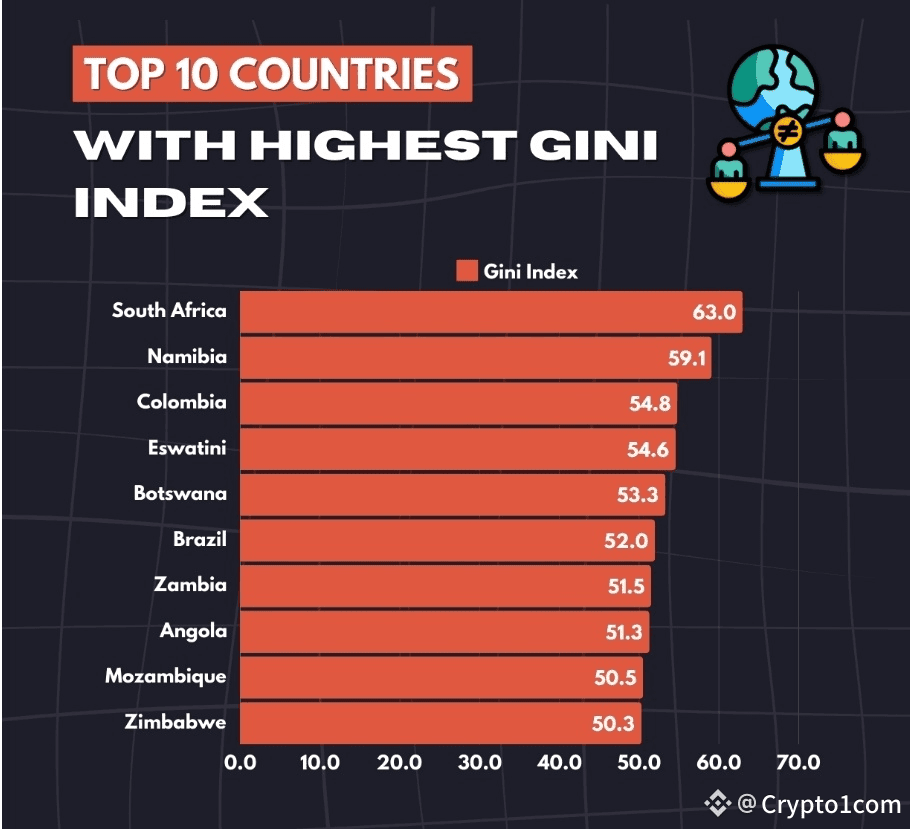
The World Bank’s latest World Inequality Report states that the richest 10% of the global population control over 76% of total household wealth, while the bottom 50% account for just 2%. Income inequality has become a major challenge in many countries globally. Several African and Latin American countries rank among the top countries with highest income inequality. According to the Gini Index, Nations like South Africa, Namibia, and Colombia have some of the highest inequality levels in the world.
According to the United Nations, today, 71% of people live in countries where inequality has increased. Additionally, since 1990, income inequality has also grown in most developed countries and some middle-income nations, like China and India.
How Income Inequality is Measured?
The Gini index is a widely used measure of income inequality. It ranges from 0 to 1 (or 0 to 100 in percentage form), where 0 means perfect equality and 1 means extreme inequality. The World Bank regularly publishes Gini Index data to highlight income gaps around the world.
Countries With the Highest Income Inequality
Country , Gini Index
1 South Africa. 63
2 Namibia. 59.1
3 Colombia. 54.8
4 Eswatini. 54.6
5 Botswana. 53.3
6 Brazil. 52
7 Zambia. 51.5
8 Angola. 51.3
9 Mozambique. 50.5
10 Zimbabwe. 50.3
South Africa
Despite being one of Africa’s most developed economies, South Africa’s Gini index has remained high since 1982. The country’s Gini index currently hovers around 63, which represents a big gap between the rich and poor. According to the IMF, the top 20 percent of the country’s population holds over 68 percent of income, while the bottom 40 percent holds only 7%. It shows South Africa’s income distribution is highly skewed towards the richest 20%. Even today, the country’s history of apartheid left many people without fair economic opportunities.
Namibia
Namibia, a neighboring country to South Africa, is one of the most unequal countries in the world. According to the World Bank, the country’s latest Gini index hovers around 59, which was 61.0 in 2010 and 63.3 in 2004. This high score shows a large gap in income and wealth among the people. Since gaining independence in 1990, Namibia has made much progress in reducing poverty, but income and wealth are still very unevenly distributed in the country.
Colombia
Being one of South America’s largest economies, Colombia is facing some of the highest levels of income inequality in the world. The country has a Gini score of 54, which shows a significant gap between the rich and poor. According to Statista, In 2022, the richest 20% of Colombians held about 59.6% of the country’s income, up from 57% in 2012. This indicates a growing concentration of wealth among richest in Colombia over the decade.
Additionally, Inequality in Colombia has lasted for generations. It is made worse by years of conflict, limited access to quality education, and land concentration in few hands.
Brazil
Brazil has one of the highest levels of income inequality in the world, even with strong economic growth. The country’s high Gini Index of 53 shows a serious income gap between the rich and poor. Brazil has made some progress in reducing inequality through social programs like Bolsa Família in the early 2000s. However, the problem continues across generations. Additionally, the richest 1% control a large share of the country’s income, while many people lack access to afford basic needs. Unequal access to education, racial disparities, and a large informal job market are some of the important drivers of inequality in Brazil.
Additionally, Eswatini, Botswana, Zambia, Angola, Mozambique, and Zimbabwe also have a gini index greater than 50. It shows the prevalence of high inequality in these countries. The Gini Index shows that most highly unequal countries are developing nations, mainly in Africa. However, the UN reports that since 1990, income inequality has also increased in many developed countries and middle-income nations like China and India.
